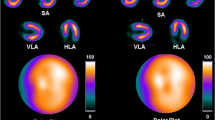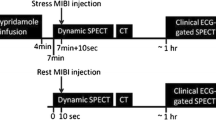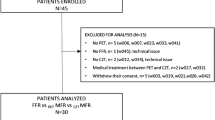Abstract
Background
We attempted to validate the performance of a fast myocardial perfusion imaging (MPI) protocol in diagnostically challenging patients.
Methods
78 patients with ΒΜΙ > 24.9, LVH or three vessels disease underwent two sequential gated-MPI studies. The first at 15 (Early Imaging, EI) and the second at 45 (Late Imaging, LI) minutes post 99mTc-injection, at both stress and rest. Counts over heart (H), liver (Liv) and subdiaphragmatic space (Sub) and image quality, and myocardial perfusion and function parameters were compared between the two protocols. Coronary angiography was performed within 2 months from MPI, and ROC analysis was used to compare the diagnostic accuracy for the detection of ≥50% diameter luminal stenosis.
Results
Quality was optimal-good in 93% of EI and 98% of LI studies (P = .12), H/Liv and stress H/Sub ratios were similar, but rest H/Sub ratio was lower in EI (P = .009). SSS [10 (0 to 46) vs 9 (0 to 36), P = .006] and SDS [3 (0 to 35) vs 2 (0 to 34), P = .02] were higher in EI protocol. LVEF, motion and thickening scores did not differ between the two protocols. A highly significant (P < .001) linear relationship with clinically negligible mean differences in Bland-Altman analysis was observed for all perfusion and function-related data. Sensitivity (EI 81%, LI 80%) and specificity (65% for both) did not differ (P = .23) between the two protocols.
Conclusion
The fast protocol is technically feasible and diagnostically accurate compared to the established protocol in diagnostically challenging patients.







Similar content being viewed by others
Abbreviations
- CAD:
-
Coronary artery disease
- SSS:
-
Summed stress score
- SDS:
-
Summed difference score
- SRS:
-
Summed rest score
- LVEDV:
-
LV end-diastolic volume
- LVESV:
-
LV end-systolic volume
- BAA:
-
Bland-Altman analysis
- TMD:
-
Total ischemic mass defect
- ICC:
-
Intraclass correlation coefficient
- QCA:
-
Quantitative coronary angiography
References
WHO. The top ten causes of death. Fact sheet no 310; 2013.
Malvern PAMR. The Myocardial Perfusion Imaging Market Guide (U.S.) Supplement to the U.S. Imaging Market Guide. Inc 2007.
Einstein AJ, Moser KW, Thompson RC, Cerqueira MD, Henzlova MJ. Radiation dose to patients from cardiac diagnostic imaging. Circulation 2007;116:1290-305.
Henzlova MJ, Cerqueira MD, Mahmarian JJ, Yao SS. Stress protocols and tracers. J Nucl Cardiol 2006;13:e80-90.
Holly TA, Abbott BG, Al-Mallah M, Calnon DA, Cohen MC, DiFilippo FP, et al. Single photon-emission computed tomography. J Nucl Cardiol 2010;17:941-73.
Hesse B, Tagil K, Cuocolo A, Anagnostopoulos C, Bardies M, Bax J, Bengel F, Busemann Sokole E, Davies G, Dondi M, Edenbrandt L, Franken P, Kjaer A, Knuuti J, Lassmann M, Ljungberg M, Marcassa C, Marie PY, McKiddie F, O’Connor M, Prvulovich E, Underwood R, van Eck-Smit B. EANM/ESC procedural guidelines for myocardial perfusion imaging in nuclear cardiology. Eur J Nucl Med Mol Imaging 2005;32:855-97.
Jain D, Wackers FJ, Mattera J, McMahon M, Sinusas AJ, Zaret BL. Biokinetics of technetium-99 m-tetrofosmin: myocardial perfusion imaging agent: implications for a one-day imaging protocol. J Nucl Med 1993;34:1254-9.
Giorgetti A, Rossi M, Stanislao M, Valle G, Bertolaccini P, Maneschi A, et al. Feasibility and diagnostic accuracy of a gated SPECT early-imaging protocol: a multicenter study of the Myoview Imaging Optimization Group. J Nucl Med 2007;48:1670-5.
Lang RM, Badano LP, Mor-Avi V, Afilalo J, Armstrong A, Ernande L, et al. Recommendations for cardiac chamber quantification by echocardiography in adults: an update from the American Society of Echocardiography and the European Association of Cardiovascular Imaging. Eur Heart J Cardiovasc Imaging 2015;16:233-70.
Mahajan N, Polavaram L, Vankayala H, Ference B, Wang Y, Ager J, et al. Diagnostic accuracy of myocardial perfusion imaging and stress echocardiography for the diagnosis of left main and triple vessel coronary artery disease: a comparative meta-analysis. Heart 2010;96:956-66.
Burrell S, MacDonald A. Artifacts and pitfalls in myocardial perfusion imaging. J Nucl Med Technol 2006;34:193-211.
Hansen CL, Woodhouse S, Kramer M. Effect of patient obesity on the accuracy of thallium-201 myocardial perfusion imaging. Am J Cardiol 2000;85:749-52.
Youden WJ. Index for rating diagnostic tests. Cancer 1950;3:32-5.
DeLong ER, DeLong DM, Clarke-Pearson DL. Comparing the areas under two or more correlated receiver operating characteristic curves: a nonparametric approach. Biometrics 1988;44:837-45.
Dvorak RA, Brown RK, Corbett JR. Interpretation of SPECT/CT myocardial perfusion images: common artifacts and quality control techniques. Radiographics 2011;31:2041-57.
Nuyts J, Dupont P, Van den Maegdenbergh V, Vleugels S, Suetens P, Mortelmans L. A study of the liver-heart artifact in emission tomography. J Nucl Med 1995;36:133-9.
Matsunari I, Tanishima Y, Taki J, Ono K, Nishide H, Fujino S, et al. Early and delayed technetium-99m-tetrofosmin myocardial SPECT compared in normal volunteers. J Nucl Med 1996;37:1622-6.
Hattori N, Tamaki N, Masuda I, Taniguchi Y, Kitano H, Kudoh T, et al. An ultrashort 1-day protocol of Tc-99m tetrofosmin. Clin Nucl Med 1999;24:85-91.
Tadehara F, Yamamoto H, Tsujiyama S, Hinoi T, Matsuo S, Matsumoto N, et al. Feasibility of a rapid protocol of 1-day single-isotope rest/adenosine stress Tc-99m sestamibi ECG-gated myocardial perfusion imaging. J Nucl Cardiol 2008;15:35-41.
Matsumoto N, Sato Y, Suzuki Y, Yoda S, Kunimasa T, Kato M, et al. Usefulness of rapid low-dose/high-dose 1-day 99mTc-sestamibi ECG-gated myocardial perfusion single-photon emission computed tomography. Circ J 2006;70:1585-9.
Philippe L, Merino B, Blaire T, Bailliez A, Casset-Senon D, Levy M, et al. Tetrofosmin early time gated post-stress single-photon emission computed tomography imaging: feasibility and potential benefits. J Nucl Cardiol 2011;18:62-72.
Mut F, Giubbini R, Vitola J, Lusa L, Sobic-Saranovic D, Peix A, et al. Detection of post-exercise stunning by early gated SPECT myocardial perfusion imaging: results from the IAEA multi-center study. J Nucl Cardiol 2014;21:1168-76.
Miller TD, Askew JW, O’Connor MK. New toys for nuclear cardiologists. Circ Cardiovasc Imaging 2011;4:5-7.
Shaw LJ, Berman DS, Maron DJ, Mancini GB, Hayes SW, Hartigan PM, et al. Optimal medical therapy with or without percutaneous coronary intervention to reduce ischemic burden: results from the Clinical Outcomes Utilizing Revascularization and Aggressive Drug Evaluation (COURAGE) trial nuclear substudy. Circulation 2008;117:1283-91.
Di Carli M, Czernin J, Hoh CK, Gerbaudo VH, Brunken RC, Huang SC, et al. Relation among stenosis severity, myocardial blood flow, and flow reserve in patients with coronary artery disease. Circulation 1995;91:1944-51.
Cerqueira MD, Weissman NJ, Dilsizian V, Jacobs AK, Kaul S, Laskey WK, et al. Standardized myocardial segmentation and nomenclature for tomographic imaging of the heart. A statement for healthcare professionals from the Cardiac Imaging Committee of the Council on Clinical Cardiology of the American Heart Association. J Nucl Cardiol 2002;9:240-5.
Berman DS, Abidov A, Kang X, Hayes SW, Friedman JD, Sciammarella MG, et al. Prognostic validation of a 17-segment score derived from a 20-segment score for myocardial perfusion SPECT interpretation. J Nucl Cardiol 2004;11:414-23.
Disclosure
No relationships with industry or forms of financial support to be disclosed.
Author information
Authors and Affiliations
Corresponding author
Additional information
See related editorial, doi:10.1007/s12350-016-0461-z.
Rights and permissions
About this article
Cite this article
Katsikis, A., Theodorakos, A., Kouzoumi, A. et al. Fast myocardial perfusion imaging with 99mTc in challenging patients using conventional SPECT cameras. J. Nucl. Cardiol. 24, 1314–1327 (2017). https://doi.org/10.1007/s12350-016-0431-5
Received:
Revised:
Published:
Issue Date:
DOI: https://doi.org/10.1007/s12350-016-0431-5




